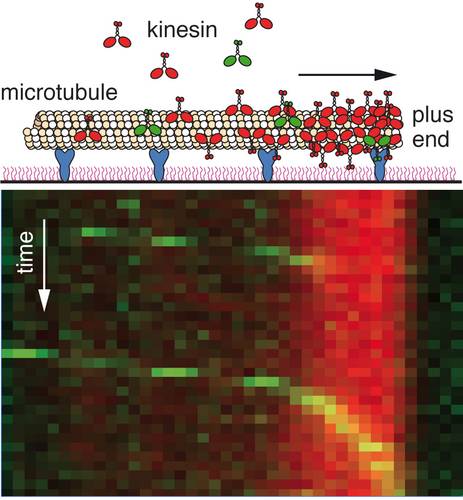
Kinesin motors, which walk in a highly-processive manner towards the plus end of a microtubule, form traffic jams due to their propensity to stay associated with the end for an extended period of time. The associated slow-down of individual motors labeled with a green fluorophore has been experimentally visualized by single-molecule microscopy in the background of many motors labeled with a red fluorophore (see kymograph in the lower panel).
Motor proteins like kinesin using microtubules as tracks are able to deliver cargoes rapidly and reliably throughout the cytoplasm– despite the crowdedness of the interior of cells. To understand the molecular properties of the motors that ensure the continuity of cellular transport in crowded environments, a research team headed by research group leader and director Jonathon Howard at the MPI-CBG and Stefan Diez at B CUBE of the Technische Universität Dresden reconstituted traffic jams with purified molecular motors. Furthermore, the Dresden researchers explored the conditions under which traffic jams form or do not form – using experiments that vary the properties of the individual motors as well as through theory and simulations.
The analysis, which is a dramatic new example of the collective behavior of interacting molecules, provides insight into the logistics of intracellular transport. Traffic jams occurred when the motor density exceeded a critical value or when motor dissociation from the microtubule ends was so slow that it resulted in a pileup. Transport kinesins are moving moderately slow and dissociate from microtubules rapidly – this may be evolutionary adaptations to avoid the formation of traffic jams in cells.
Cécile Leduc, Kathrin Padberg-Gehle, Vladimír Varga, Dirk Helbing, Stefan Diez, and Jonathon Howard:
Molecular crowding creates traffic jams of kinesin motors on microtubules
PNAS Early Edition, 19 March 2012
doi: 10.1073/pnas.1107281109